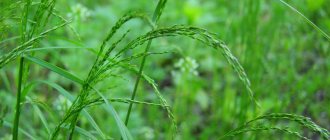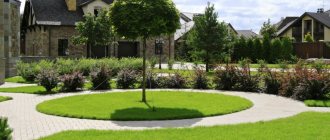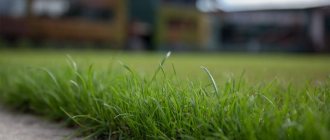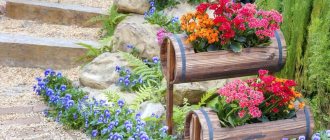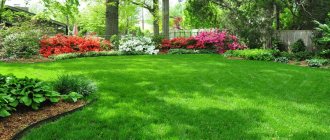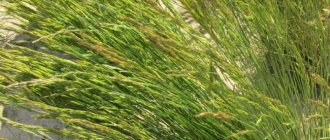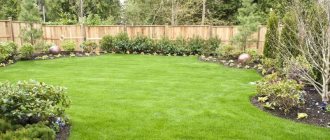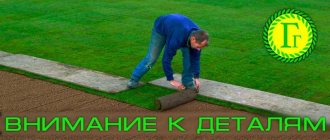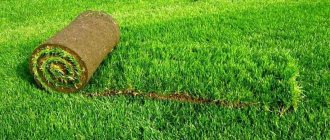Comb or ctenophore
Perennial plant 25-80 cm high. Fibrous root system, without creeping underground shoots. Flowering lasts almost all summer. Not suitable for parterre lawns; it conflicts with fescue and bentgrass. Ideal for Moorish lawns. Included in sports and ordinary lawns. It grows to final development within 2-3 years. Resistant to trampling. It grows until late autumn, remaining green even during snowfall. In spring, it pleases the eye with green leaves immediately after the snow cover melts. Reproduces and spreads by seeds. Prefers sandy soil. Tolerates drought calmly.
Herbs with specific properties
There are certain types of low-growing lawn grasses that are adapted to specific growing conditions. They cannot be called universal, but for certain areas of the site it is recommended to plant them.
Recent Entries
5 working ways to use tar in the garden 7 indoor plants that help you get married even in adulthood Indoor plants that can bloom in trouble
Thus, oak grove bluegrass has a high ability to grow in partial shade. Those. under garden trees and in places near buildings where light rarely reaches, this plant will rid the lawn of bald spots and pale cover. True, you must take into account that the bluegrass cannot form a dense root system, and therefore does not tolerate movement and frequent mowing.
Swamp bluegrass will save the situation on lawns with high humidity where drainage has not been carried out. It forms a beautiful green cover and develops strong roots, but does not live long and requires frequent reseeding. It can be combined with white bentgrass, which also grows well in moist soil. But its decorative properties are lower than those of bluegrass, and its lifespan is about 8 years.
For parterre lawns on which you don’t plan to walk at all, you can use dog bentgrass. This is one of the most elegant grasses in appearance, because it has an emerald color and delicate, thin blades of grass. This kind of lawn is also called “velvet” because from a distance it looks like expensive fabric. But with all its external advantages, the plant is very capricious. It lives for about 5 years, has weak roots, grows slowly and is absolutely not resistant to trampling.
If it is important for you that your lawn looks aesthetically pleasing within a month or two, then select a mixture that contains meadow fescue. This is the fastest growing cereal, which will close its stems within 2 months. It can be used in its pure form for a temporary lawn, which is destined to grow in one place for 4 years, because the grass does not live longer. In addition, meadow fescue has weak roots that are afraid of trampling. But as part of a mixture, this cereal can be very useful as an addition to the main herb. For example, meadow bluegrass grows slowly, and until it reaches full strength, the empty spaces will be successfully covered by the stems of meadow fescue.
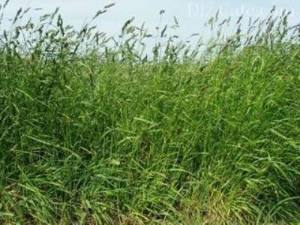
Meadow fescue will save owners when they urgently need to make the lawn decorative, because after 2 months the blades of grass form a continuous thick carpet
Your lawn will be thick in the first summer, although a little patchy. Meadow fescue has wide stems and light coloring, which will look contrasting against the background of narrow dark green blades of bluegrass. Next year, when the main grass begins to grow vigorously, it will simply squeeze out this grass and take its place.
You can also grow an unpretentious lawn from Irish moss, read about it:
Cocksfoot
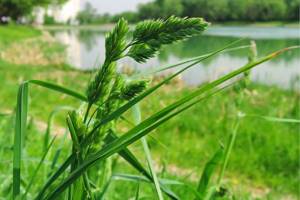
Perennial 30-150 cm high. Fibrous root system reaching a depth of up to 100 cm. Blooms in summer. Shade-tolerant. Doesn't like being trampled. The plant forms hummocks. Displaces other grains. Not for use on high quality lawns. Reaches full development at 2-3 years of life. It is undemanding to soil, but does not like excessively moist soil. Due to the shallow root system, the plant has relatively low winter hardiness.
Which grass to choose for planting a lawn: review of first-class varieties + their photos
There is a lot of hassle with your lawn: does the grass look less decorative than on the package of seeds, does it freeze in places, turns yellow, thins out and is overgrown with weeds? Perhaps you chose the wrong varieties for our climatic conditions. We will tell you today which grass for the lawn is best for you, and which varieties are best to choose.
- Rules for choosing seeds for a lawn
- A short video about lawn grass
- Types of grasses and lawn mixtures
- Herbal mixtures
- The best varieties of lawn grasses for the Russian climate
- The most common questions about lawn grasses
Rules for choosing seeds for a lawn
The grass on the lawn should be perennial, frost-resistant and fast-growing. These are important conditions for an ideal lawn, but not the most important. We list the main factors for purchasing seeds for sowing on the lawn, which are best chosen in the store:
- Adaptation to certain climate conditions;
- Good development of the root system;
- Saturation of greenery and uniformity of seedlings;
- Ability for vegetative propagation;
- Good haircut tolerance.
You should not neglect the general rules for choosing lawn grass: shelf life of the material, pre-treatment of seeds, manufacturer’s warranties, etc.
A short video about lawn grass
Types of grasses and lawn mixtures
It is best to use grasses for the lawn. They have a good root system, produce uniform green shoots, help remove weeds and have an excellent decorative appearance after cutting. The most commonly sown varieties of grass are meadow bluegrass, bentgrass, ryegrass, fescue and others. Various grass mixtures are also popular.
Ryegrass is one of the elite varieties of grass. It looks very beautiful in any place free from planting. This variety is sensitive to watering and loves mineral fertilizing.
Clover
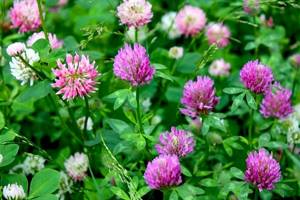
Perennial 50-60 cm high. Forms a powerful root system, with a penetration depth into the soil of up to 2.5 m. Light-loving plant. Does not require careful care. Undemanding to soil quality. Displaces weeds. Supplies the earth with nitrogen. Resistant to trampling. Recovers quickly. The flowering period is from May to the end of September. Tolerates frosts well. The increased soil moisture produced by clover attracts snails and slugs.
Grasses for the lawn
There are quite a few varieties of lawn grass. Based on the development of the root system, they are divided into groups listed in the following table.
| Type | Description | Plants |
| Rhizomatous | The root develops in width. Aboveground shoots grow from nodes that appear on its branches over time. | – Meadow foxtail – Bluegrass – White bentgrass |
| Taproot | Plants are distinguished by their unpretentiousness and decorative appearance. Additional shoots are formed on the main root. | – Horned frogwort – Sainfoin |
| Loose bushes | Shoots appear on the aboveground part of the plant. Only one node can be seen in the root system. | – Pasture ryegrass – Timofeevka |
| Flat bushes | New shoots, after merging with old ones, form hummocks. | – Belous – Red fescue |
Another important factor is the intended location for planting the lawn grass.
The upper tier is formed from light-loving crops, which include awnless brome and vicoleaf sainfoin. To create the middle one, semi-upper grasses are used, for example, timothy, hybrid clover or alfalfa. To make the lower tier, you will need red fescue and bentgrass.
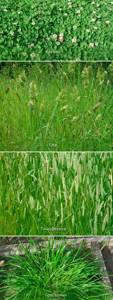
Gardeners should also pay attention to the lifespan of plants. Lawn grasses can be perennials or annuals. The following are used as monocultures and components of mixtures:
Bluegrass
This early cereal is valued for its rich color, high resistance to temperature changes and shade tolerance. With regular mowing, it forms an even cover. The root system is weak, so the plant should not be planted in areas that are subject to trampling. The advantages of perennials include unpretentiousness, rapid growth and decorative appearance, while the disadvantages are slow root survival. Bluegrass can be a good base for a grass mixture;
White clover
The hybrid is bright. Gardeners who have planted this crop on their site can carry out low mowing. The lawn will not suffer from this;
Fescue
Most often they choose a complex consisting of two varieties (red and sheep). The result is a green carpet that is resistant to shading and lack of moisture. This type of lawn does not require special care;
Small-leaved timothy
The plant is characterized by rare endurance. It is not afraid of shade, low temperatures and high humidity levels;
Pasture ryegrass
Its leaves are richly colored. The crop is planted if there is a need for temporary plantings. Ryegrass does not tolerate low temperatures well, so it should only be sown as a monoculture in warm areas;
Polevitsa
Pobegonosnaya produces long shoots of a light green hue. Among its characteristic features is intensive tillering. Thin bentgrass is not afraid of frequent haircuts and sudden changes in temperature. Having planted it on his plot, the gardener will receive a lawn of deep green color. Dog bentgrass is included in grass mixtures for ornamental lawns;
Hedgehog
An unpretentious crop with a powerful root system, the seeds of which are often included in grass mixtures. It prevents weeds from growing;
Comb
Resistant to waterlogging, drought, frost. Its short shoots form a dense cover that can be mowed low.
Bonfire without bones
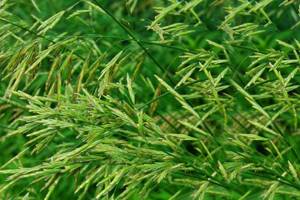
A perennial grass 30-120 cm high. Long rhizomes, going deep into the ground up to 1.5-2 m, give rise to numerous shoots. It is not picky about soil, prefers poor sandy soils. Light-loving plant. It tolerates trampling well. It is characterized by high frost and winter resistance. Propagated by seeds. Sowing time is early May. Blooms in late June - early July. Used for meadow lawns. Not resistant to repeated mowing.
Why do you need a lawn?
First of all, it's just beautiful. A soft green carpet is pleasant to the eye and to walk on, it helps us forget about stress and remember Mother Nature.
In addition, in addition to purely aesthetic purposes, lawns have a number of important beneficial properties, which, in particular, include the following:
Lawns are protected from dust. Thus, according to experts, 1 square meter occupied by a grass lawn evaporates 200 grams of water per hour, which creates a ground-level moist layer of air that prevents the formation of dust particles. In a city where there are no areas with bare ground, and everywhere there is either grass, or asphalt, or tiles, it is incomparably cleaner. Lawns prevent the formation of many harmful microorganisms (phytocidal properties)
In other words, lawn grass is a natural antiseptic, which is especially important for areas where children play. You can safely walk barefoot on the grass.
Lawn games
Lawn grass (especially large areas of it) is capable of lowering the air temperature at a height of up to 1 meter by forming a continuous exchange of air and moistening it by 5-7 degrees
This is especially important for areas with hot and dry climates. A cozy relaxation area in the shade of a vineyard or acacia must certainly have a lawn, this way we will get complete shelter from the scorching sun and midday heat. Another useful property of the lawn, which should not be forgotten by both summer residents and those people who choose seeds just to sow a small home front garden, is that many varieties of grass contribute to the natural fertilization of the soil with such important substances as nitrogen, potassium and mineral salts.
Bluegrass
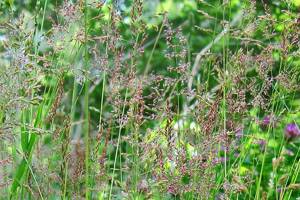
Perennial plant 20-90 cm high. One of the most popular lawn grasses. The roots grow well, reaching a depth of up to 1 meter. Not picky about soil. Reaches full development at 2-3 years. Easily tolerates drought. Blooms in summer. Develops in early spring. After mowing, it forms an elastic and even cover. Does not tolerate frequent haircuts. Prefers a sunny location. Suitable for shaded areas. In good conditions it is resistant to trampling. Propagated by seeds. In late autumn it stops growing, remaining green during snowfall.
Lawn grasses photos and names. Herb seeds
Regardless of what kind of lawn you choose for your site, when choosing seeds you should pay attention to several points:
- They should not be expired, nor should they have obvious signs of fungus or mold damage.
- Their quality must be confirmed by international certificates.
In addition, grass seeds for lawns must have the following characteristics:
Improves blood circulation through the body, improves mental functioning and ability to concentrate, may be helpful in relieving symptoms of Alzheimer's disease and is used to treat hemorrhoids. An effective herbal tea benefits for colds, chest problems, and coughs. Taken hot may cause sweating. Also useful for stomach problems and constipation.
By shoot height
It promotes appetite and heals digestive disorders. It is sometimes included in cough medicine and is used to treat rheumatism. Green Tea – This herbal tea keeps free radicals under control, reduces the risk of cancer and helps prevent heart disease. Ooh, we haven't noticed these herbal tea benefits!
You can choose to sow a monoculture or a seed mixture.
Monoculture is the grass seeds of one type; it is used infrequently due to its high cost, fastidiousness in care and growing conditions. However, these shortcomings are fully compensated by the quality of coverage they provide. Monocultures are most often used to make sports fields or English lawns, the photo of which you see.
Lawn grasses photos and names. Herb seeds
Honey – Soothes the throat and is loaded with immune-boosting antioxidants. Hops – Contrary to its name, hops have a calming effect, relieve dyspepsia and are an old pain reliever. Another good afternoon tea. It also relieves spasms and muscle spasms and stimulates appetite. Previously it was used as a preservative. Sprinkle into your pillowcase for insomnia.
How to take medicinal herbs correctly?
Horsetail -. It helps the body absorb calcium and nourishes nails, skin, hair and connective tissue. It will remove excess oil from the skin and hair and make individual hair stronger, thicker and more elastic. Jasmine - flowers make a delicious and appetizing tea. Jasmine has a calming effect and makes a good after-dinner drink. Some believe it is an aphrodisiac.
An herb blend is a combination of seeds best suited to a particular region. Thanks to the combination of the best qualities of individual species, a grass mixture lawn is decorative and not so demanding to care for.
When purchasing, it is also important to study the seeding rate for a monoculture or mixture. Most often it depends on the individual characteristics of the cereal or mixture
If there are no clear instructions on the bag of seeds, then the norm is considered to be 50 grams per 1 square meter. when sowing using a Hamilton automatic seeder, drum type. If you do this manually, then you need to add 10% to the figure.
Kava or Kava-kava is nature's Valium without side effects either affecting the mind, or making one sluggish. It helps you get a good night's sleep, relaxes you and reduces water retention - a really good herbal tea. In the Western world it was used to stop bleeding, regulate menstruation and stimulate appetite.
This makes a soothing douche for vaginal irritations. Lavender is relaxing and helps people sleep and feel calm. Recent research suggests it has many other herbal tea benefits, and one study suggests it may replace sleeping pills.
Fescue
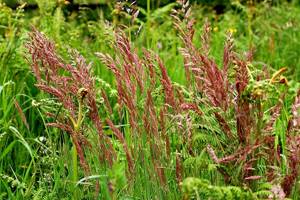
A perennial grass with a height of 20–140 cm. The most popular grass in landscaping. The final formation of the plant occurs in 2-3 years. Shade tolerant, prefers sunny places. It tolerates frequent mowing and trampling. Has good winter hardiness. Drought-resistant plant. Propagated by seeds. Red fescue is part of sports and parterre lawns. Sheep fescue is used in parterre lawns.
Grass mixture Pony Russian agro
The Pony Russian Agro grass mixture belongs to the group of Lilliputian lawns, or dwarf lawns. It is very decorative, has a beautiful green color, and does not require frequent cutting. The lawn is dense, allowing children to play. It can withstand medium-intensity shade, withstands abrasion and trampling well, medium-duration drought does not spoil its appearance, and winters well.
Composition: Meadow bluegrass varieties Marcus and Zeptor - 75%, Red fescue varieties Ryder - 25%.
Grass mixture Pony
Slender bentgrass and mountain dog bentgrass
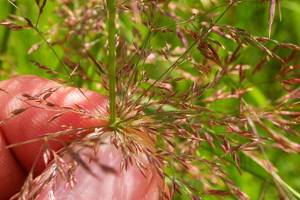
Perennial 15-120 cm high. The root system is well developed and does not form creeping underground shoots. They tolerate drought well and prefer sunny places. They have high frost resistance. They easily tolerate trampling and mowing. They are unpretentious to the soil. They bloom in July - early August. Included in mixtures for parterre and low-growing lawns. Propagated by seeds or division. Peak growth occurs in spring.
Ryegrass
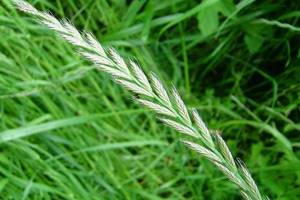
A perennial grass up to 30 cm high. The root system is fibrous, well developed in the upper layers of the soil. Flowering is observed in June-July. Sun-loving plant. Drought resistant. Prefers sandy loam soils. In summer it loses its decorative effect. Propagated by seeds and division of the bush. Insufficient frost and winter hardiness, loss of grass stand after wintering is about 30%. It has high wear resistance, which makes it an important component for sports turf mixtures. Included in all types of lawn grass mixtures.
Timofeevka
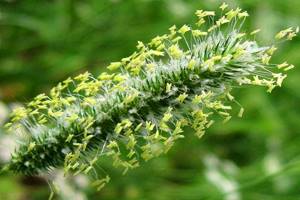
A perennial plant 25-120 cm high. It has short creeping rhizomes. Reaches full development in the second year. Blooms in late spring - early summer. Does not tolerate trampling well. It grows well only on moist clay and loamy soils. Doesn't like drought. Withstands even the harshest winter. It does not tolerate low cutting, so it is used primarily for sowing ordinary lawns on heavy soils. Propagated by seeds.
